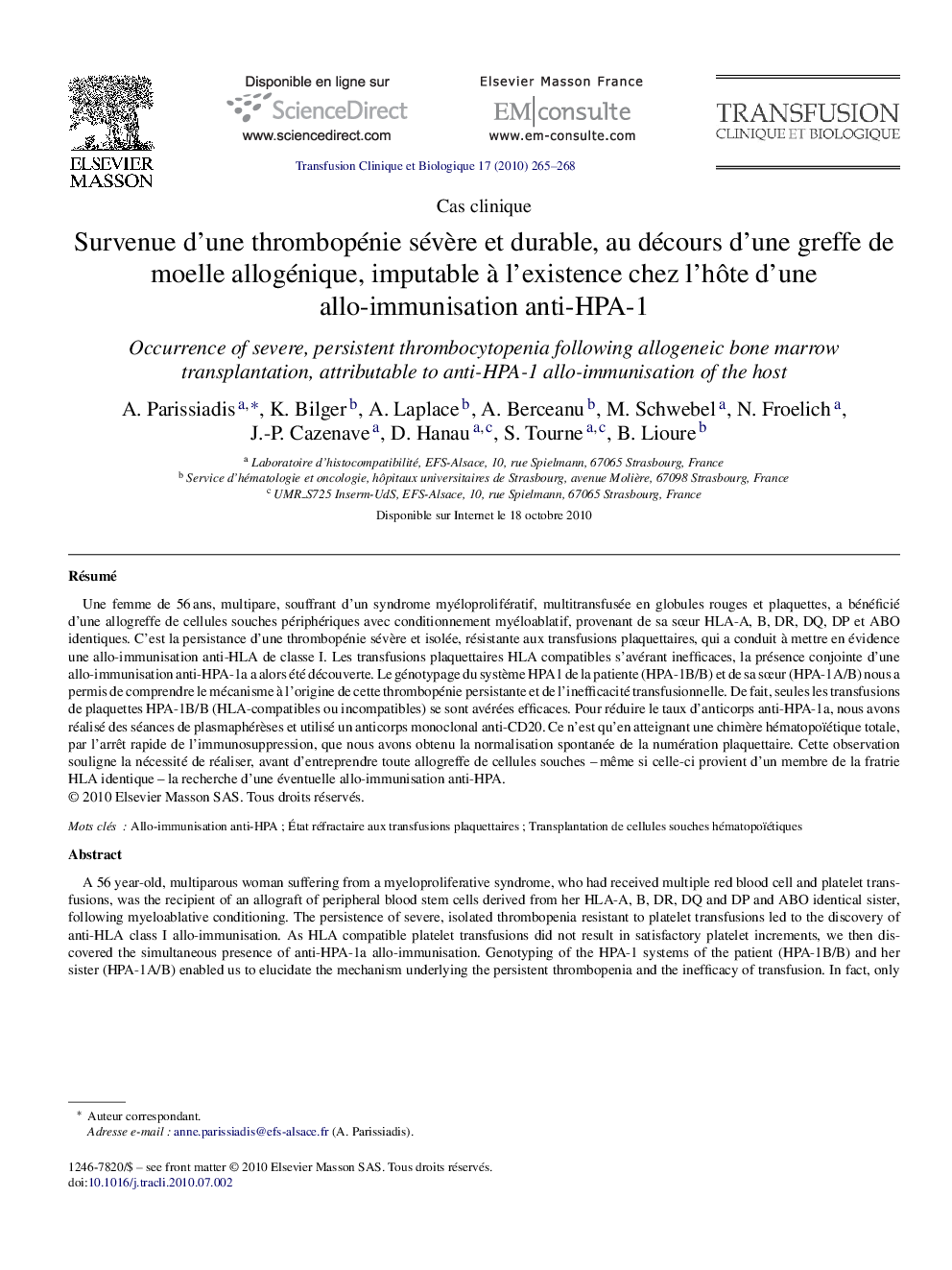| کد مقاله | کد نشریه | سال انتشار | مقاله انگلیسی | نسخه تمام متن |
|---|---|---|---|---|
| 1105847 | 954209 | 2010 | 4 صفحه PDF | دانلود رایگان |

RésuméUne femme de 56 ans, multipare, souffrant d’un syndrome myéloprolifératif, multitransfusée en globules rouges et plaquettes, a bénéficié d’une allogreffe de cellules souches périphériques avec conditionnement myéloablatif, provenant de sa sœur HLA-A, B, DR, DQ, DP et ABO identiques. C’est la persistance d’une thrombopénie sévère et isolée, résistante aux transfusions plaquettaires, qui a conduit à mettre en évidence une allo-immunisation anti-HLA de classe I. Les transfusions plaquettaires HLA compatibles s’avérant inefficaces, la présence conjointe d’une allo-immunisation anti-HPA-1a a alors été découverte. Le génotypage du système HPA1 de la patiente (HPA-1B/B) et de sa sœur (HPA-1A/B) nous a permis de comprendre le mécanisme à l’origine de cette thrombopénie persistante et de l’inefficacité transfusionnelle. De fait, seules les transfusions de plaquettes HPA-1B/B (HLA-compatibles ou incompatibles) se sont avérées efficaces. Pour réduire le taux d’anticorps anti-HPA-1a, nous avons réalisé des séances de plasmaphérèses et utilisé un anticorps monoclonal anti-CD20. Ce n’est qu’en atteignant une chimère hématopoïétique totale, par l’arrêt rapide de l’immunosuppression, que nous avons obtenu la normalisation spontanée de la numération plaquettaire. Cette observation souligne la nécessité de réaliser, avant d’entreprendre toute allogreffe de cellules souches – même si celle-ci provient d’un membre de la fratrie HLA identique – la recherche d’une éventuelle allo-immunisation anti-HPA.
A 56 year-old, multiparous woman suffering from a myeloproliferative syndrome, who had received multiple red blood cell and platelet transfusions, was the recipient of an allograft of peripheral blood stem cells derived from her HLA-A, B, DR, DQ and DP and ABO identical sister, following myeloablative conditioning. The persistence of severe, isolated thrombopenia resistant to platelet transfusions led to the discovery of anti-HLA class I allo-immunisation. As HLA compatible platelet transfusions did not result in satisfactory platelet increments, we then discovered the simultaneous presence of anti-HPA-1a allo-immunisation. Genotyping of the HPA-1 systems of the patient (HPA-1B/B) and her sister (HPA-1A/B) enabled us to elucidate the mechanism underlying the persistent thrombopenia and the inefficacy of transfusion. In fact, only transfusion of HPA-1B/B platelets (HLA compatible or incompatible) proved to be efficacious. To reduce the level of anti-HPA-1a antibodies, we performed plasmapheresis sessions and used an anti-CD20 monoclonal antibody. It was only on achieving total haematopoietic chimerism, through rapid interruption of the immunosuppression, that we obtained spontaneous normalisation of the platelet count. The present case emphasises the necessity, before undertaking any allograft of haematopoietic stem cells – even if the latter come from a strictly HLA identical member of the family – of performing a search for eventual anti-HPA allo-immunisation.
Journal: Transfusion Clinique et Biologique - Volume 17, Issue 4, October 2010, Pages 265–268